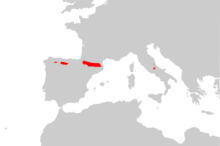Pyrenean chamois
| Pyrenean chamois | ||||||||||||
|---|---|---|---|---|---|---|---|---|---|---|---|---|

Pyrenean chamois ( Rupicapra pyrenaica ) |
||||||||||||
| Systematics | ||||||||||||
|
||||||||||||
| Scientific name | ||||||||||||
| Rupicapra pyrenaica | ||||||||||||
| Bonaparte , 1845 |
The Pyrenean chamois ( Rupicapra pyrenaica ) is a species of even-toed ungulate living in southern Europe . It is closely related to the (actual) chamois that also occurs in Central Europe .
features
Pyrenean chamois reach a head body length of 90 to 130 centimeters, to which a short, 3 to 4 centimeters long tail comes. The shoulder height is around 80 centimeters and the weight varies between 24 and 50 kilograms. The fur is short and reddish in color in summer (more distinctly red than that of the chamois), the winter fur is long, dense and dark brown and has characteristic white spots on the neck, shoulders and flanks. Both sexes have horns up to 20 centimeters long, these protrude vertically upwards and then bend backwards like a hook.
distribution and habitat
Despite their name, Pyrenean chamois ( Rupicapra pyrenaica pyrenaica ) live not only in the Pyrenees , but also in the Cantabrian Mountains ( Rupicapra pyrenaica parva ), in northern Spain and in the Apennines in central Italy - the Italian stocks are known as Abruzzo chamois ( Rupicapra pyrenaica ornata ) listed as a separate subspecies. Their habitat are meadows and rocky regions in the high mountains - forests largely avoid them.
Way of life
These animals are skilled climbers who climb to higher regions in summer, but go to deeper areas in winter. The females live in groups with the young, while the males are solitary for most of the year.
They are herbivores that feed on herbs, grasses, mosses, lichens and other plants depending on the season.
After a gestation period of around 170 days, the female usually gives birth to a single young in spring, twins and triplets are rare.
Pyrenean chamois and people
The stocks have been severely decimated by hunting, and there is also the loss of habitat. The population is estimated at around 35,000 animals. The IUCN lists the species as not endangered.
On the other hand, the Abruzzo chamois is considered endangered, it is very rare and there have probably never been a particularly large number of animals of this subspecies in the last few centuries. In the 1920s there were more, because from then on they enjoyed better protection. Later, during World War II , the population size decreased again to as low as a few dozen animals. In 1980 there were again about 400 individuals, up to the present day this number has been increased to about 1100 individuals. The IUCN lists this subspecies of the Pyrenees chamois as endangered. With only 3 populations present, there is extremely little genetic diversity. The Abruzzo chamois is particularly endangered by the forage and territorial competition with other animals, especially with native goats. Sometimes poaching also occurs, which does not seem to affect the populations in Abruzzo National Park , their main refuge, too much. In addition, there are some animals as genetic reserves in zoological gardens, for example in the Hellabrunn zoo in Munich.
literature
- Ronald M. Nowak: Walker's Mammals of the World. Johns Hopkins University Press, 1999, ISBN 0-8018-5789-9 .
Web links
- Information on Animal Diversity Web
- Rupicapra pyrenaica in the endangered Red List species the IUCN 2006. Posted by: Caprinae Specialist Group, 1996. Retrieved on 1 August, 2008.

